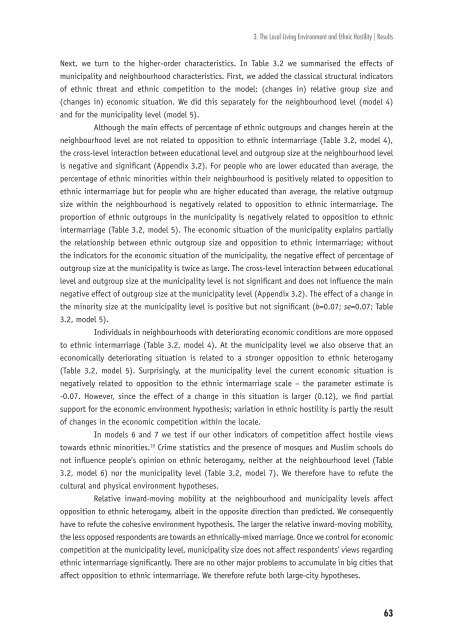Ethnic Hostility among Ethnic Majority and Minority Groups
Ethnic Hostility among Ethnic Majority and Minority Groups
Ethnic Hostility among Ethnic Majority and Minority Groups
Create successful ePaper yourself
Turn your PDF publications into a flip-book with our unique Google optimized e-Paper software.
3. The Local Living Environment <strong>and</strong> <strong>Ethnic</strong> <strong>Hostility</strong> | Results<br />
Next, we turn to the higher-order characteristics. In Table 3.2 we summarised the effects of<br />
municipality <strong>and</strong> neighbourhood characteristics. First, we added the classical structural indicators<br />
of ethnic threat <strong>and</strong> ethnic competition to the model: (changes in) relative group size <strong>and</strong><br />
(changes in) economic situation. We did this separately for the neighbourhood level (model 4)<br />
<strong>and</strong> for the municipality level (model 5).<br />
Although the main effects of percentage of ethnic outgroups <strong>and</strong> changes herein at the<br />
neighbourhood level are not related to opposition to ethnic intermarriage (Table 3.2, model 4),<br />
the cross-level interaction between educational level <strong>and</strong> outgroup size at the neighbourhood level<br />
is negative <strong>and</strong> signifi cant (Appendix 3.2). For people who are lower educated than average, the<br />
percentage of ethnic minorities within their neighbourhood is positively related to opposition to<br />
ethnic intermarriage but for people who are higher educated than average, the relative outgroup<br />
size within the neighbourhood is negatively related to opposition to ethnic intermarriage. The<br />
proportion of ethnic outgroups in the municipality is negatively related to opposition to ethnic<br />
intermarriage (Table 3.2, model 5). The economic situation of the municipality explains partially<br />
the relationship between ethnic outgroup size <strong>and</strong> opposition to ethnic intermarriage; without<br />
the indicators for the economic situation of the municipality, the negative effect of percentage of<br />
outgroup size at the municipality is twice as large. The cross-level interaction between educational<br />
level <strong>and</strong> outgroup size at the municipality level is not signifi cant <strong>and</strong> does not infl uence the main<br />
negative effect of outgroup size at the municipality level (Appendix 3.2). The effect of a change in<br />
the minority size at the municipality level is positive but not signifi cant (b=0.07; se=0.07; Table<br />
3.2, model 5).<br />
Individuals in neighbourhoods with deteriorating economic conditions are more opposed<br />
to ethnic intermarriage (Table 3.2, model 4). At the municipality level we also observe that an<br />
economically deteriorating situation is related to a stronger opposition to ethnic heterogamy<br />
(Table 3.2, model 5). Surprisingly, at the municipality level the current economic situation is<br />
negatively related to opposition to the ethnic intermarriage scale – the parameter estimate is<br />
-0.07. However, since the effect of a change in this situation is larger (0.12), we fi nd partial<br />
support for the economic environment hypothesis; variation in ethnic hostility is partly the result<br />
of changes in the economic competition within the locale.<br />
In models 6 <strong>and</strong> 7 we test if our other indicators of competition affect hostile views<br />
towards ethnic minorities. 10 Crime statistics <strong>and</strong> the presence of mosques <strong>and</strong> Muslim schools do<br />
not infl uence people’s opinion on ethnic heterogamy, neither at the neighbourhood level (Table<br />
3.2, model 6) nor the municipality level (Table 3.2, model 7). We therefore have to refute the<br />
cultural <strong>and</strong> physical environment hypotheses.<br />
Relative inward-moving mobility at the neighbourhood <strong>and</strong> municipality levels affect<br />
opposition to ethnic heterogamy, albeit in the opposite direction than predicted. We consequently<br />
have to refute the cohesive environment hypothesis. The larger the relative inward-moving mobility,<br />
the less opposed respondents are towards an ethnically-mixed marriage. Once we control for economic<br />
competition at the municipality level, municipality size does not affect respondents’ views regarding<br />
ethnic intermarriage signifi cantly. There are no other major problems to accumulate in big cities that<br />
affect opposition to ethnic intermarriage. We therefore refute both large-city hypotheses.<br />
63












